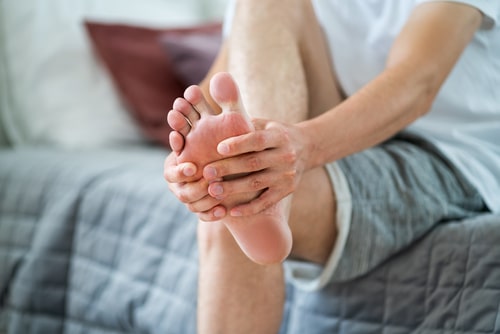Navigating Flat Feet VA Rating: Your Complete Guide
 Pes Planus, commonly known as flat feet, is a condition that affects the arch of the foot, causing it to collapse and the entire sole to make contact with the ground. While flat feet can occur naturally, it can also be a common condition among veterans due to military service. Veterans who are experiencing symptoms of flat feet may be eligible for VA disability benefits. In this blog, we will explore the VA benefits available for pes planus, understand the VA rating system for flat feet, and discuss secondary conditions that can be linked to this condition.
Pes Planus, commonly known as flat feet, is a condition that affects the arch of the foot, causing it to collapse and the entire sole to make contact with the ground. While flat feet can occur naturally, it can also be a common condition among veterans due to military service. Veterans who are experiencing symptoms of flat feet may be eligible for VA disability benefits. In this blog, we will explore the VA benefits available for pes planus, understand the VA rating system for flat feet, and discuss secondary conditions that can be linked to this condition.
Understanding VA Rating for Pes Planus (Flat Feet)
When it comes to determining the level of disability and the corresponding compensation, the VA uses the VA disability rating schedule, also known as the diagnostic code. This rating system evaluates the functional impairment caused by pes planus and assigns a disability rating from 0 to 100 percent. The rating takes into account the severity of the condition, the impact on mobility and daily activities, and any secondary conditions that may arise as a result of flat feet. By understanding the VA rating system, veterans can better navigate the process of seeking disability benefits for pes planus.
Defining Pes Planus and its Connection to Veterans
Pes planus, commonly known as flat feet, occurs when the foot's arch collapses, leading to the entire sole of the foot touching the ground. This condition often leads to discomfort, pain, and challenges in performing physical activities. Flat feet are particularly prevalent among veterans, likely due to the strenuous demands of military life, including prolonged periods of standing, marching, and bearing heavy loads. Factors contributing to the development of flat feet include age, body weight, and genetic predispositions. However, the physical strains associated with military service can aggravate this condition. Veterans who experience symptoms like foot and arch pain or difficulties in physical activities might be eligible for VA disability benefits.
For more information on flat feet, visit the Mayo Clinic's overview of flat feet. To understand eligibility and application for VA disability benefits, the U.S. Department of Veterans Affairs provides comprehensive resources.
Service Connecting Your Pes Planus for VA Disability
To service-connect pes planus (flat feet) for VA disability benefits, veterans must satisfy three key elements: a current disability, an in-service event or injury, and a medical nexus linking the current disability to the in-service event. Understanding and providing evidence for each of these elements is crucial.
1. Current Disability: Veterans must first establish the existence of a current disability due to flat feet. This involves providing medical documentation of the condition. Evidence can include current medical records, diagnostic imaging results, and assessments from healthcare professionals that confirm the presence and severity of flat feet.
2. In-Service Event or Injury: The second element requires evidence of an event or injury during military service that could have caused or aggravated the flat feet. This could be records of rigorous physical activities, such as prolonged marching or carrying heavy equipment, which are common in military service. Service medical records, duty assignments, and even personal diaries or letters that describe the physical demands faced during service can serve as valuable evidence.
3. Medical Nexus: The most critical element is establishing a medical nexus, or link, between the current flat feet condition and the in-service event or injury. This involves obtaining a medical opinion from a healthcare professional who can attest to the likelihood that the veteran's flat feet were caused or worsened by their military service. The medical professional should review the veteran's entire medical history, including service and post-service medical records, to provide a well-informed opinion.
For each of these elements, it's important for veterans to gather as much relevant evidence as possible. This can include medical records, both from their time in service and after, statements from fellow service members, and any other documentation that supports their claim. Consulting with a VA attorney can help ensure that the evidence is thorough and well-presented to maximize the likelihood of establishing a service connection for pes planus.
VA's Evaluation Criteria Rating Code for Various Ratings
The VA rating criteria for pes planus (flat feet) are based on the severity of the condition and its impact on the veteran's mobility and daily activities. The VA rates flat feet under 38 CFR § 4.71a, Schedule of Ratings – Musculoskeletal System, specifically under diagnostic code 5276. You can find the information on 38 C.F.R. § 4.71a, diagnostic code 5276 at the following link: Electronic Code of Federal Regulations (eCFR) - Title 38: Pensions, Bonuses, and Veterans' Relief. This link will take you to the official eCFR website where you can view the full details of this regulation. The ratings range from 0% to 50%, depending on the symptoms and their severity:
0 Percent VA Rating for Flat Feet (Bilateral or Unilateral)

Veterans diagnosed with pes planus (flat feet) may be assigned a 0 percent VA disability rating if their condition presents with mild symptoms and does not significantly impair functionality. This rating, while not providing monetary compensation, formally acknowledges the existence of flat feet as a service-connected condition. This acknowledgement can be crucial, especially when claiming compensation for secondary conditions that may arise as a consequence of flat feet.
For veterans with a 0 percent rating due to mild pes planus, it's still advisable to seek regular medical attention and maintain detailed documentation of the condition. Flat feet can potentially deteriorate over time, leading to greater impairment. Regular consultations with healthcare professionals and consistent updating of medical records are key in keeping an accurate and detailed account of the condition's progression. This diligent record-keeping can be vital if the condition worsens, potentially warranting a reassessment for increased disability compensation.
It's important to note that the 0 percent rating is specifically given when the condition, though present, is effectively managed with the use of arch support, insoles, or a built-up shoe, and does not cause significant functional limitations. This rating underscores the VA's recognition of the condition's service connection, which may become crucial should the condition aggravate or lead to other medical issues..
10 Percent Pes Planus VA Rating (Bilateral or Unilateral)

A veteran may be eligible for a 10 percent VA disability rating under diagnostic code 5276 for pes planus (flat feet) if their condition, though more pronounced than cases warranting a 0 percent rating, still doesn't cause significant disruption to daily life. This rating applies to cases of bilateral flat feet, where both feet are affected. The criteria for a 10 percent rating include the presence of symptoms like foot pain, discomfort, and a necessity for arch support, but these symptoms must not be debilitating.
The 10 percent rating acknowledges the impact of pes planus on the veteran's musculoskeletal system, though it is considered to have a moderate impact. Veterans with this rating are encouraged to continually monitor their condition, as pes planus can progress over time. Regular medical consultations and treatment are advisable to manage symptoms and prevent further degradation of the condition.
It's important to note that the 10 percent rating specifically applies when there is evidence of weight-bearing over the medial great toe, inward bowing of the Achilles tendon, and pain on manipulation and use of the feet. This rating reflects the VA's recognition of the condition's impact on the veteran's health and daily functioning, albeit at a level that is not highly debilitating.
For more detailed guidance on VA disability ratings and pes planus, veterans should consider consulting legal professionals focusing on veterans' benefits.
20 Percent VA Rating for Pes Planus (Unilateral)

Veterans with unilateral pes planus (flat feet affecting only one foot) may be eligible for a 20 percent VA disability rating. This rating is applicable when there is severe flat feet, as evidenced by objective markers such as marked deformity (pronation, abduction, etc.), pronounced pain upon manipulation and use of the foot, signs of swelling after use, and the presence of characteristic callosities.
The 20 percent rating for unilateral severe pes planus reflects the significant impact this condition has on the veteran's mobility and daily activities. It takes into account the level of physical discomfort, pain, and the difficulty the veteran may face during physical tasks due to the deformity and associated symptoms in the affected foot.
30 Percent VA Disability Rating for Flat Feet (Bilateral)

The difference between a 20 percent and a 30 percent VA disability rating for pes planus (flat feet) primarily lies in the extent and bilateral nature of the condition.
A 30 percent rating is given for bilateral severe flat feet, where both feet exhibit these severe symptoms and impairments. The criteria for the 30 percent rating are the same as the 20 percent rating – marked deformity, pain on use and manipulation, swelling, and callosities – but they must be present in both feet. This higher rating recognizes the greater overall impact on the veteran's mobility and daily activities when both feet are significantly affected.
In summary, the primary difference is that the 20 percent rating applies to severe symptoms in one foot, while the 30 percent rating applies when both feet are severely affected by pes planus.
50 Percent Flat Feet VA Rating (Bilateral)

Veterans exhibiting pronounced bilateral pes planus (severe flat feet affecting both feet) with severe symptoms may qualify for a 50 percent VA disability rating. This rating is indicative of substantial disability and acknowledges the profound impact the condition has on the veteran's everyday life.
A 50 percent rating is assigned in cases where there are marked symptoms such as marked pronation, extreme tenderness of plantar surfaces of the feet, marked inward displacement and severe spasm of the tendo achillis on manipulation, not improved by orthopedic shoes or appliances. These symptoms often lead to severe limitations in physical activities and mobility challenges, greatly affecting the veteran's quality of life.
The 50 percent rating recognizes the need for extensive medical intervention and support. Veterans with this rating may require specialized treatments like orthopedic shoes or custom orthotic inserts to manage the pain and to aid in mobility. This high rating underlines the severity of the condition and the extent to which it necessitates ongoing medical care and lifestyle adjustments to manage the symptoms.
Secondary Conditions Linked to Flat Feet

Flat feet can lead to the development of secondary conditions, particularly within the musculoskeletal system, due to the foot deformity. Pes planus can contribute to the development of conditions such as rheumatoid arthritis, ankle pain, knee pain, and back pain. The severity of flat feet can vary from person to person, and the impact on the musculoskeletal system can range from mild discomfort to chronic pain and limitations in mobility.
Common Conditions Secondary to Flat Feet
Flat feet, medically known as pes planus, can be a precursor to various secondary conditions within the musculoskeletal system due to the alteration in foot structure. The degree of flat feet can range significantly, impacting the musculoskeletal system from mild discomfort to severe chronic pain and mobility restrictions.
1. Plantar Fasciitis: This condition stems from issues with arch support typical in flat feet, leading to pain and inflammation in the plantar fascia, the crucial ligament supporting the foot's arch. More about plantar fasciitis and its connection to flat feet can be found in a study from the Journal of Bone and Joint Surgery.
2. Achilles Tendonitis: The misalignment caused by flat feet may place excessive strain on the Achilles tendon, causing inflammation and pain at the back of the ankle. The American Academy of Orthopedic Surgeons provides further information on this condition.
3. Knee Pain: Altered foot alignment due to flat feet can lead to improper weight distribution, resulting in additional stress on the knee joint and subsequent pain. The A rthritis Foundation offers insights into how foot health affects knee pain.
4. Back Pain: The foot misalignment can affect the entire body, including the back. Flat feet can cause an abnormal gait, leading to back discomfort due to changed body mechanics. The S pine Health website discusses the impact of flat feet on back health.
These secondary conditions can significantly diminish a veteran's quality of life, causing pain and limitations in daily activities. It's crucial for individuals with flat feet to be vigilant about the potential onset of these conditions and seek appropriate medical care and support.
Navigating Through a Denied Flat Feet Claim

For veterans whose flat feet VA claim has been denied, it's important to understand the appeals process under the Veterans Appeals Improvement and Modernization Act of 2017. This process offers three options to review a VA decision: Supplemental Claim, Higher-Level Review, and Board Appeal.
1. Supplemental Claim: If you have new and relevant evidence that wasn't available during the initial review of your case, you can file a Supplemental Claim. This option allows you to present additional evidence to support your claim for flat feet-related disability.
2. Higher-Level Review: This option involves a review of your case by a more senior claims adjudicator. It's important to note that you cannot submit new evidence with this option. Instead, it's a review of the existing decision based on the evidence that was already submitted.
3. Board Appeal: You can appeal to the Board of Veterans' Appeals for a review of your case by a Veterans Law Judge. This option is for veterans who wish to challenge the decision further after exploring the other review options.
When preparing for an appeal, it's crucial to gather all relevant medical records and documentation related to your flat feet condition. If your claim was denied due to a lack of service connection or insufficient medical evidence, obtaining a medical opinion with a nexus letter from a healthcare professional can be beneficial. This document should link your condition directly to your military service.
It's also recommended to carefully monitor your claim status and manage submissions effectively, avoiding common pitfalls like submitting duplicate documents or overwhelming the VA with unnecessary paperwork. If needed, veterans can seek assistance from a VA-accredited attorney or agent to navigate the process.
Remember, the VA appeals process can take time, so it's important to manage your expectations regarding the timeline. If your flat feet condition worsens after your initial claim is denied, you can file for an increased rating based on the worsened condition, which involves submitting updated medical evidence.
The Role of Individual Unemployability in Pes Planus Cases
Individual Unemployability (IU) is a benefit program offered by the VA that allows veterans with disabilities to receive compensation at the 100 percent disability rating, even if they do not have a disability rating of 100 percent. For veterans with severe symptoms of flat feet that impact their ability to work, IU benefits may be an option. By demonstrating the severity of flat feet, the impact it has on employment, and the inability to maintain substantial gainful employment, veterans with flat feet may be eligible for IU benefits.
How Flat Feet can lead to Individual Unemployability?
Severe symptoms of flat feet can make it difficult for veterans to work, especially in jobs that require long periods of standing or use of the feet. The pain, discomfort, and limitations caused by flat feet can significantly impact the veteran's ability to perform job-related tasks, resulting in the inability to maintain substantial gainful employment.
Jobs that involve long periods of standing, walking, or physically demanding tasks can exacerbate the symptoms of flat feet, making it challenging to complete job requirements and sustain employment. Veterans with flat feet may experience severe pain, limitations in mobility, and decreased productivity due to the condition. These factors can make it difficult to secure and maintain suitable employment, leading to eligibility for Individual Unemployability benefits.
To support an Individual Unemployability claim, veterans with flat feet should provide medical evidence that demonstrates the severity of their symptoms, the limitations they face in the workplace, and the impact of the condition on their ability to work. This evidence can include medical records, statements from healthcare professionals, and testimonies from supervisors or coworkers who have witnessed the veteran's struggles in the workplace.
What is the VA rating for flat feet?
The VA rating for flat feet depends on the severity and functional limitations it causes. Typically, flat feet are rated between 0% to 50%, with higher ratings given for more severe cases that significantly impact mobility and ability to perform daily activities.
Preparing for a Flat Feet VA C&P Exam

A Compensation and Pension (C&P) exam is a crucial part of the VA disability benefits process. It evaluates the severity of your flat feet condition and the impact it has on your daily life. To prepare for a C&P exam for flat feet, consider the following:
- Gather your medical records: Compile all relevant medical records, including diagnostic test results and treatment history, to provide a comprehensive overview of your flat feet condition.
- Document your symptoms: Keep a record of your symptoms and how they affect your daily activities, such as pain levels, limitations in mobility, and difficulties with tasks that require standing, walking, or using your feet.
- Be prepared to discuss the severity of your condition: The examiner will likely ask questions about the severity of your flat feet, the frequency and duration of symptoms, and the impact of the condition on your daily life.
- Bring objective evidence: If you have any diagnostic reports, such as X-rays, MRI scans, or orthopedic assessments, that support the severity of your flat feet, bring them to the exam to provide objective evidence.
- Explain the impact of flat feet on your ability to work: If your flat feet condition affects your employment, make sure to communicate this to the examiner, providing specific examples of how the condition limits your ability to perform job-related tasks.
- By being prepared and providing thorough information during the C&P exam, you can ensure that the examiner has a clear understanding of the severity of your flat feet and the impact it has on your life.
What Can You Expect at a VA C&P Exam for Flat Feet?
A VA C&P exam for flat feet is conducted by a medical professional to evaluate the severity of your condition and determine the appropriate disability rating. During the exam, the examiner will assess the objective evidence, the severity of your symptoms, and the impact of the condition on your daily life.
The examiner will review your medical records, including any diagnostic test results, treatment history, and statements from healthcare professionals. They will also inquire about the severity of your symptoms, the frequency and duration of your symptoms, and the impact of flat feet on your mobility and ability to perform daily activities.
The examiner will use the diagnostic code, which outlines the rating criteria for flat feet, to assess the severity of your condition. This code takes into consideration factors such as characteristic callosities, arch support needs, marked inward displacement of the great toe, plantar fascia pain, and other symptoms associated with the condition.
The C&P exam may involve physical tests, such as range of motion tests, walking, or observations of your gait, to evaluate the functional limitations caused by your flat feet. It is essential to provide a detailed account of your symptoms, the severity of your condition, and the impact it has on your daily life during the exam. By providing the examiner with accurate and comprehensive information, you can ensure that your disability rating reflects the true nature of your condition.
Frequently Asked Questions
What is Pes Planus and how does it affect veterans?
Pes Planus, commonly known as flat feet, is a condition where the foot arch collapses. It can cause pain, discomfort, and difficulties with physical activities. Veterans may be eligible for VA benefits if their flat feet are connected to their military service, including compensation for the condition and assistance with orthotics or medical treatment.
What documentation or evidence is necessary to support a claim for VA benefits related to Pes Planus?
To support a claim for VA benefits related to Pes Planus, you'll need medical records showing a diagnosis, service records indicating the condition occurred during active duty or as a result of service-related injuries, statements from medical professionals about the impact on daily life and work abilities, and any additional supporting documentation.
Conclusion
In conclusion, understanding the VA benefits for Pes Planus (Flat Feet) is crucial for veterans seeking disability compensation. It is important to familiarize yourself with the VA rating system and the evaluation criteria for different ratings. Whether you are looking to establish service connection, navigate through a denied claim, or explore secondary conditions linked to flat feet, having the right documentation and evidence is essential.
If you need assistance with your flat feet claim or have any questions, do not hesitate to reach out to us. Our team of experts is here to provide guidance and support throughout the process. We understand the challenges that veterans face and are dedicated to helping you receive the benefits you deserve. Contact us today for a consultation.












